Hip
Discover the best Hip Replacement Surgeon in Delhi from Life In Motion Clinic. We at LMC top leading Hip Replacement surgery hospital in Saket, South Delhi, India. Book an online appointment with Dr. Rahul Sharma, Orthopaedic Surgeon, discuss more in detail regarding Surgical and Non-Surgical Hip replacement treatments.
Hip Anatomy
-
Hip Anatomy
The hip joint is the largest weight-bearing joint in the human body. It is also referred to as a ball and socket joint and is surrounded by muscles, ligaments, and tendons. The thigh bone or femur and the pelvis join to form the hip joint.
Any injury or disease of the hip will adversely affect the joint's range of motion and ability to bear weight.
-
Physical Examination of Hip
The hip joint is the largest weight-bearing joint in the human body. It is also referred to as a ball and socket joint and is surrounded by muscles, ligaments, and tendons. The thigh bone or femur and the pelvis join to form the hip joint.
Any injury or disease of the hip will adversely affect the joint's range of motion and ability to bear weight.
Conditions
-
Avascular Necrosis
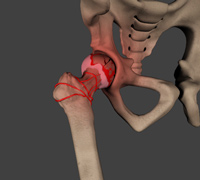 Avascular necrosis, also called osteonecrosis is a condition in which bone death occurs because of inadequate blood supply to it. Lack of blood flow may occur when there is a fracture in the bone or a joint dislocation that may damage nearby blood vessels.
Avascular necrosis, also called osteonecrosis is a condition in which bone death occurs because of inadequate blood supply to it. Lack of blood flow may occur when there is a fracture in the bone or a joint dislocation that may damage nearby blood vessels. -
Osteoarthritis of the Hip
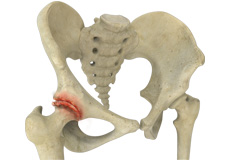 Osteoarthritis also called degenerative joint disease is the most common form of arthritis. It occurs most often in older people. This disease affects the tissue covering the ends of bones in a joint (cartilage). In a person with osteoarthritis, the cartilage becomes damaged and worn out causing pain, swelling, stiffness and restricted movement in the affected joint.
Osteoarthritis also called degenerative joint disease is the most common form of arthritis. It occurs most often in older people. This disease affects the tissue covering the ends of bones in a joint (cartilage). In a person with osteoarthritis, the cartilage becomes damaged and worn out causing pain, swelling, stiffness and restricted movement in the affected joint. -
Inflammatory Arthritis of the Hip
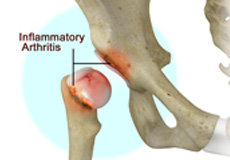 Inflammation of the joints is referred to as arthritis. The inflammation arises when the smooth covering (cartilage) at the end surfaces of the bones wears away. In some cases, the inflammation is caused when the lining of the joint becomes inflamed as part of an underlying systemic disease.
Inflammation of the joints is referred to as arthritis. The inflammation arises when the smooth covering (cartilage) at the end surfaces of the bones wears away. In some cases, the inflammation is caused when the lining of the joint becomes inflamed as part of an underlying systemic disease. -
Snapping Hip
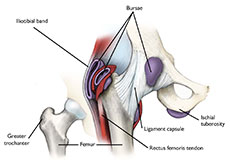 The hip is an important joint that helps us walk, run and jump. The ball-and-socket joint in the hip is formed between the round end of the femur (thighbone) and the cup-shaped socket of the acetabulum (part of the hip bone).
The hip is an important joint that helps us walk, run and jump. The ball-and-socket joint in the hip is formed between the round end of the femur (thighbone) and the cup-shaped socket of the acetabulum (part of the hip bone). -
Femoroacetabular Impingement
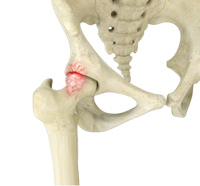 Femoroacetabular impingement (FAI) is a condition where there is too much friction in the hip joint from bony irregularities causing pain and decreased the range of hip motion. The femoral head and acetabulum rub against each other creating damage and pain to the hip joint.
Femoroacetabular impingement (FAI) is a condition where there is too much friction in the hip joint from bony irregularities causing pain and decreased the range of hip motion. The femoral head and acetabulum rub against each other creating damage and pain to the hip joint. -
Hip Labral Tear
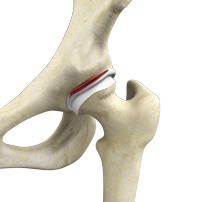 A hip labral tear is an injury to the labrum, the cartilage that surrounds the outside rim of your hip joint socket. The hip joint is a ball and socket joint in which the head of the femur is the ball and the pelvic acetabulum forms the socket.
A hip labral tear is an injury to the labrum, the cartilage that surrounds the outside rim of your hip joint socket. The hip joint is a ball and socket joint in which the head of the femur is the ball and the pelvic acetabulum forms the socket. -
Hip Instability
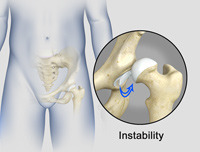 The hip plays an important role in supporting the upper body weight while standing, walking and running, and hip stability is crucial for these functions. The femur (thigh bone) and acetabulum (hip bone) join to form the hip joint, while the labrum (tissue rim that seals the hip joint) and the ligaments lining the hip capsule maintain the stability of the hip.
The hip plays an important role in supporting the upper body weight while standing, walking and running, and hip stability is crucial for these functions. The femur (thigh bone) and acetabulum (hip bone) join to form the hip joint, while the labrum (tissue rim that seals the hip joint) and the ligaments lining the hip capsule maintain the stability of the hip. -
Hip Fracture
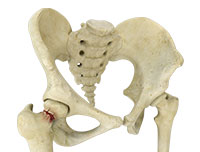 The hip joint is a "ball and socket" joint. The "ball" is the head of the femur or thigh bone, and the "socket" is the cup-shaped acetabulum. The joint surface is covered by a smooth articular surface that allows pain-free movement in the joint.
The hip joint is a "ball and socket" joint. The "ball" is the head of the femur or thigh bone, and the "socket" is the cup-shaped acetabulum. The joint surface is covered by a smooth articular surface that allows pain-free movement in the joint. -
Hip Pain
 Hip pain, one of the common symptoms patients complain of, may not always be felt precisely over the hip joint. Pain may be felt in and around the hip joint and the cause for pain is multifactorial. The exact position of your hip pain suggests the probable cause or underlying condition causing pain.
Hip pain, one of the common symptoms patients complain of, may not always be felt precisely over the hip joint. Pain may be felt in and around the hip joint and the cause for pain is multifactorial. The exact position of your hip pain suggests the probable cause or underlying condition causing pain. -
Transient Osteoporosis of the Hip
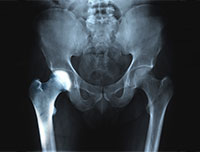 Transient osteoporosis of the hip is a rare condition that causes bone loss temporarily in the upper part of the thighbone (femur). It is mostly found in young or middle-aged men between the ages of 30 and 60, and women in their later stages of pregnancy or early postpartum period (following childbirth).
Transient osteoporosis of the hip is a rare condition that causes bone loss temporarily in the upper part of the thighbone (femur). It is mostly found in young or middle-aged men between the ages of 30 and 60, and women in their later stages of pregnancy or early postpartum period (following childbirth). -
Hip Bursitis
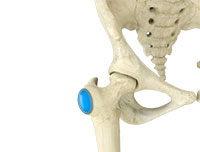 Hip bursitis is a painful condition caused by inflammation of a bursa in the hip. Bursae are fluid-filled sacs present in joints between bone and soft tissue to reduce friction and provide cushioning during movement.
Hip bursitis is a painful condition caused by inflammation of a bursa in the hip. Bursae are fluid-filled sacs present in joints between bone and soft tissue to reduce friction and provide cushioning during movement. -
Gluteus Medius Tear
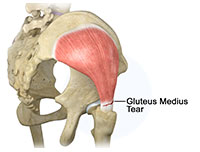 A gluteus medius tear is a condition characterized by severe strain on the gluteus medius muscle that results in partial or complete rupture of the muscle.
A gluteus medius tear is a condition characterized by severe strain on the gluteus medius muscle that results in partial or complete rupture of the muscle. -
Chondral Lesions or Injuries
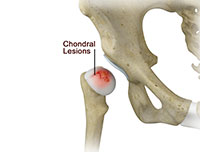 The hip joint is one of the largest weight-bearing joints in the body, formed by the thigh bone or femur and the acetabulum of the pelvis. It is a ball and socket joint with the head of the femur as the ball and the pelvic acetabulum forming the socket.
The hip joint is one of the largest weight-bearing joints in the body, formed by the thigh bone or femur and the acetabulum of the pelvis. It is a ball and socket joint with the head of the femur as the ball and the pelvic acetabulum forming the socket. -
Developmental Dysplasia
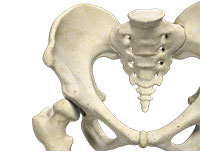 Developmental dysplasia of the hip (DDH) or Hip dysplasia is a condition which is seen in infants and young children because of developmental problems in the hip joint. The femur (thigh bone) partially or completely slips out of the hip socket causing dislocation at the hip joint. It is most common in first born baby with a family history of the disorder.
Developmental dysplasia of the hip (DDH) or Hip dysplasia is a condition which is seen in infants and young children because of developmental problems in the hip joint. The femur (thigh bone) partially or completely slips out of the hip socket causing dislocation at the hip joint. It is most common in first born baby with a family history of the disorder. -
Legg-Calve-Perthes-Disease
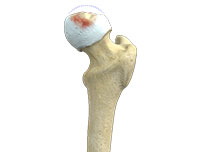 Legg-Calve-Perthes Disease (LCPD) or Perthes disease is a disorder of the hip that affects children, usually between the ages of 4 and 10. It usually involves one hip, although it can occur on both sides in some children. It occurs more commonly in boys than in girls.
Legg-Calve-Perthes Disease (LCPD) or Perthes disease is a disorder of the hip that affects children, usually between the ages of 4 and 10. It usually involves one hip, although it can occur on both sides in some children. It occurs more commonly in boys than in girls. -
Slipped Capital Femoral Epiphysis
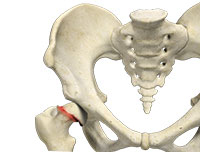 Slipped capital femoral epiphysis (SCFE) is an unusual disorder of the hip where the ball at the upper end of the thigh bone (femur) slips in a backward direction. This is caused due to the weakness of the growth plate.
Slipped capital femoral epiphysis (SCFE) is an unusual disorder of the hip where the ball at the upper end of the thigh bone (femur) slips in a backward direction. This is caused due to the weakness of the growth plate.
Procedures
Non-Surgical Treatments
-
Hip Injections
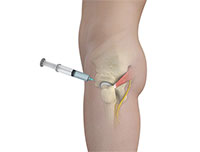 Hip joint injections involve injecting medicine directly into the hip joint to diagnose the source of pain or treat pain due to conditions such as arthritis, injury or mechanical stress of the hip joint. Hip pain may be experienced in the hip, buttock, leg or low back.
Hip joint injections involve injecting medicine directly into the hip joint to diagnose the source of pain or treat pain due to conditions such as arthritis, injury or mechanical stress of the hip joint. Hip pain may be experienced in the hip, buttock, leg or low back. -
Physiotherapy
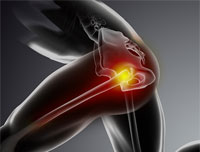 Physiotherapy or physical therapy is an exercise program that helps you to improve movement, relieve pain, encourage blood flow for faster healing, and restore your physical function and fitness level. The main aim of physical therapy is to make your daily activities, such as walking, getting in and out of bed, or climbing stairs, easier.
Physiotherapy or physical therapy is an exercise program that helps you to improve movement, relieve pain, encourage blood flow for faster healing, and restore your physical function and fitness level. The main aim of physical therapy is to make your daily activities, such as walking, getting in and out of bed, or climbing stairs, easier.
Surgical Treatments
-
Hip Arthroscopy
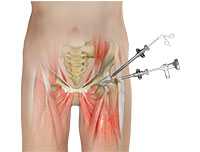 Arthroscopy, also referred to as keyhole or minimally invasive surgery, is a procedure in which an arthroscope is inserted into a joint to check for any damage and repair it simultaneously.
Arthroscopy, also referred to as keyhole or minimally invasive surgery, is a procedure in which an arthroscope is inserted into a joint to check for any damage and repair it simultaneously. -
Total Hip Replacement
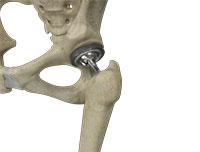 Total hip replacement is a surgical procedure in which the damaged cartilage and bone is removed from the hip joint and replaced with artificial components. The hip joint is one of the body's largest weight-bearing joints, located between the thigh bone (femur) and the pelvis (acetabulum).
Total hip replacement is a surgical procedure in which the damaged cartilage and bone is removed from the hip joint and replaced with artificial components. The hip joint is one of the body's largest weight-bearing joints, located between the thigh bone (femur) and the pelvis (acetabulum). -
Anterior Hip Replacement
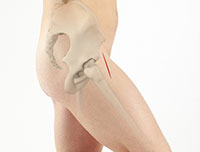 Total joint replacement surgery is one of the most advanced successful procedures in patients dealing with severe hip and knee pain. The goal of the surgery is to relieve pain and restore the normal functioning of the joint and help patient resume normal activities.
Total joint replacement surgery is one of the most advanced successful procedures in patients dealing with severe hip and knee pain. The goal of the surgery is to relieve pain and restore the normal functioning of the joint and help patient resume normal activities. -
Revision Hip Replacement
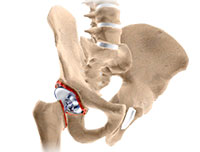 Revision hip replacement is a complex surgical procedure in which all or part of a previously implanted hip-joint is replaced with a new artificial hip-joint. Total hip replacement surgery is an option to relieve severe arthritis pain that limits your daily activities.
Revision hip replacement is a complex surgical procedure in which all or part of a previously implanted hip-joint is replaced with a new artificial hip-joint. Total hip replacement surgery is an option to relieve severe arthritis pain that limits your daily activities. -
Robotic-assisted Hip Surgery
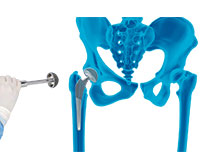 Robotic hip surgery is an advancement to a traditional hip surgery by using a robotic system to perform the surgery. The robotic system functions as an extension of the surgeon's hands and eyes.
Robotic hip surgery is an advancement to a traditional hip surgery by using a robotic system to perform the surgery. The robotic system functions as an extension of the surgeon's hands and eyes. -
Minimally Invasive Total Hip Replacement
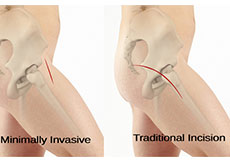 The hip joint is one of the body's largest weight-bearing joints and is the point where the thigh bone (femur) and the pelvis (acetabulum) join. It is a ball and socket joint in which the head of the femur is the ball and the pelvic acetabulum forms the socket.
The hip joint is one of the body's largest weight-bearing joints and is the point where the thigh bone (femur) and the pelvis (acetabulum) join. It is a ball and socket joint in which the head of the femur is the ball and the pelvic acetabulum forms the socket. -
Pre-op and Post-Op Hip Guidelines
 Planning for your hip surgery prepares you for the operation and helps to ensure a smooth surgery and easier recovery. Here are certain pre-operative and post-operative guidelines which will help you prepare for hip surgery.
Planning for your hip surgery prepares you for the operation and helps to ensure a smooth surgery and easier recovery. Here are certain pre-operative and post-operative guidelines which will help you prepare for hip surgery. -
Caregivers Guide for the Hip
 When your friend or loved one has undergone a hip replacement surgery, as a caregiver, you will play an important role in his/her recovery. There are various aspects you need to be aware of to ensure the safety, comfort and recovery of the patient.
When your friend or loved one has undergone a hip replacement surgery, as a caregiver, you will play an important role in his/her recovery. There are various aspects you need to be aware of to ensure the safety, comfort and recovery of the patient. -
Hip Fracture Prevention
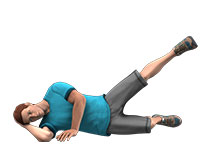 Hip fractures refer to any kind of breakage or damage in the thigh bone (femur). People over the age of 65, especially women, are highly vulnerable to hip fractures. You will require assistance after hip fractures from family members as well as health professionals and may also be required to be admitted to the hospital for further assistance.
Hip fractures refer to any kind of breakage or damage in the thigh bone (femur). People over the age of 65, especially women, are highly vulnerable to hip fractures. You will require assistance after hip fractures from family members as well as health professionals and may also be required to be admitted to the hospital for further assistance. -
Birmingham Hip Resurfacing
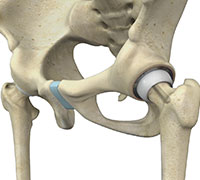 The Birmingham Hip Resurfacing (BHR) is a metal-on-metal prosthesis used in hip resurfacing procedure. Hip Resurfacing is a bone conserving procedure where the acetabulum (hip socket) is replaced and the femoral head is resurfaced. Hip resurfacing is indicated in all the individuals with arthritis where conservative treatment was a failure.
The Birmingham Hip Resurfacing (BHR) is a metal-on-metal prosthesis used in hip resurfacing procedure. Hip Resurfacing is a bone conserving procedure where the acetabulum (hip socket) is replaced and the femoral head is resurfaced. Hip resurfacing is indicated in all the individuals with arthritis where conservative treatment was a failure. -
Hip Preservation Surgery
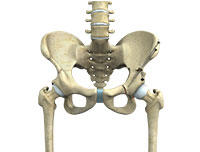 The hip is a ball and socket joint comprising of the femur (thigh bone) and the pelvic bone. The head of the femur (ball) articulates with a cavity (socket) called the acetabulum in the pelvic bone. To facilitate smooth and frictionless movement of the hip joint, the articulating surfaces of the femur head and acetabulum are covered by spongy articular cartilage.
The hip is a ball and socket joint comprising of the femur (thigh bone) and the pelvic bone. The head of the femur (ball) articulates with a cavity (socket) called the acetabulum in the pelvic bone. To facilitate smooth and frictionless movement of the hip joint, the articulating surfaces of the femur head and acetabulum are covered by spongy articular cartilage.
